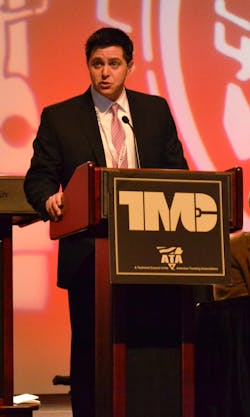NASHVILLE. Billed as a session to provide “the straight facts” on Vehicle Maintenance Reporting Standards (VMRS), a panel representing fleets, service providers, and OEMs “played the big room” in front of a lively audience this week at the Technology & Maintenance Council annual meeting.
And while there was plenty of discussion about potential pitfalls and areas of confusion, a presentation detailing the turnaround of one fleet's maintenance program provided a solid case for giving the system a serious look.
“VMRS – probably the most misunderstood thing, if you’re in maintenance, that we deal with,” said Jack Poster, who spearheads the program for TMC. “You know about your DPFs, your SCR, your DEF – whatever. But if I ask five people about VMRS I’m going to get five different answers.”
VMRS, “the shorthand of maintenance reporting,” is a structured – yet flexible – coding system of three three-digit code groups. It’s designed to be simple in concept, and can be used to track total operating systems down to individual parts. The level of coding used is entirely up to the user, and TMC, as custodian of the system, provides updates to reflect the needs of an evolving industry.
The big benefit in an age of big data is that anything that’s collected can be compared directly to data collected by others. An overview of the system is here.
For Nashville-based truckload carrier Sharp Transport, VMRS has provided the key to tremendous improvements in maintenance shop efficiency, reported Jarit Cornelius, the fleet’s director of maintenance.
Cornelius noted a “never-ending list” of areas where time and money can be wasted, such as searching for parts and tools. A particular area of concern for Sharp was in-house labor costs, and Cornelius explained that many fleets do not accurately account for “indirect costs,” or the time shop technicians and managers spend on tasks that are not directly tied to a repair order: sweeping the floor, doing paperwork, putting tools away, running across town for a part.
All of this can be tracked through VMRS codes, he emphasized. Virtually every aspect of a fleet’s performance is hurt by downtime, and while the shop doesn’t generate revenue, it can certainly save it.
“It’s never been more important to have complete control of your actual operating costs, and to dissect your results to know where you can contribute,” Cornelius said.
Adoption of VMRS isn’t just a way to keep up with costs, he added: The data can be used to detect maintenance trends and form the basis for more accurate forecasts – even to “proactively” schedule maintenance by “identifying issues before they actually become issues."
Specifically at Sharp, the parts inventory write-off was $150,000 when Cornelius started work there, and maintenance processes were generally outdated.
So the inventory was restocked based on VMRS group codes, and the shop began to use a barcode system that improved efficiency and greatly reduced paperwork.
The bottom line: In-house completed repair orders increased 20 percent while outside repair work decreased 40 percent, and total maintenance costs fell 35 percent. CSA-related vehicle maintenance fell 58 percent.
And Sharp reduced its parts inventory 72 percent while achieving an inventory accuracy of 98 percent.
“That means there’s no inefficient purchasing of parts,” he said. “We know what we need to order, how much and exactly when we need to restock.”
But, he pointed out, the goal has been to improve efficiency, not simply to reduce costs.
Getting the maintenance team on board with the shop reorganization was critical – but “the one tool that has been at the forefront of everything we do is VMRS,” Cornelius said. “This is a guaranteed way for you to contribute to your company’s success. At the end of the day, it’s still up to you to manage the results and identify what areas need improvement.”




